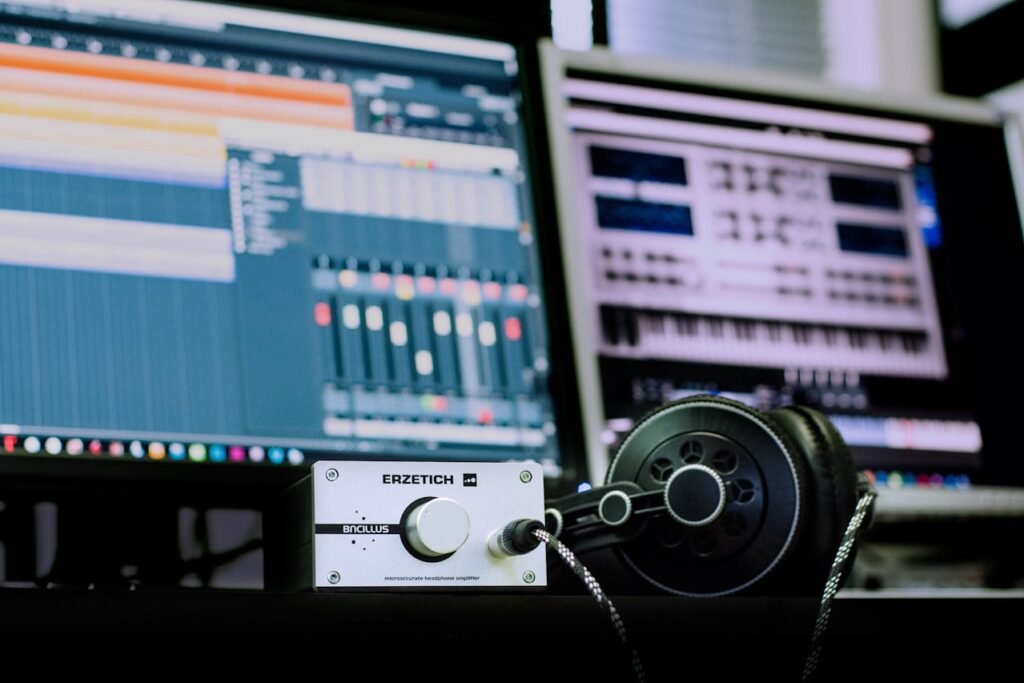In an increasingly crowded digital landscape, brands and content creators are discovering that memorable audio experiences can be just as powerful as striking visuals. Atmospheric sound design has evolved from a supporting element to a primary driver of emotional engagement, capable of transforming ordinary content into extraordinary sensory journeys that linger in audiences’ minds long after the experience ends.
The science behind audio’s emotional impact is compelling. Neuroscience research reveals that sound waves directly stimulate the limbic system—our brain’s emotional processing center—often bypassing conscious thought entirely. This immediate pathway to emotion explains why certain sounds can instantly transport us to different moods, memories, or mental states, making atmospheric audio design one of the most potent tools in a creator’s arsenal.
The Science of Atmospheric Audio Design
Psychoacoustic Principles in Action
Understanding how humans perceive and process sound is fundamental to creating effective atmospheric audio. Our auditory system doesn’t simply detect sound waves; it interprets them through complex psychological and cultural filters that shape our emotional responses.
Frequency ranges carry distinct psychological associations. Sub-bass frequencies (20-60 Hz) create feelings of power and presence, often perceived physically rather than just heard. Mid-range frequencies (200-2000 Hz) carry most speech information and emotional nuance, while higher frequencies (above 4000 Hz) contribute to clarity, excitement, or tension depending on their application.
Spatial audio positioning also plays a crucial role in creating immersive experiences. Sounds that move through three-dimensional space create depth and realism that static audio cannot achieve, engaging listeners’ natural spatial awareness and drawing them deeper into the designed audio environment.
Cultural Context and Universal Elements
While some acoustic elements trigger universal human responses—sudden loud sounds startle everyone—cultural conditioning significantly influences how we interpret atmospheric audio. Religious music, nature sounds, and ceremonial audio all carry different meanings across various cultural contexts.
Creators must balance universal appeal with cultural sensitivity when designing atmospheric experiences for global audiences. Sounds that feel peaceful and transcendent in one culture might carry entirely different connotations elsewhere, making research and testing essential components of professional audio design.
Building Effective Atmospheric Soundscapes
Layered Composition Techniques
Professional atmospheric design rarely relies on single audio elements. Instead, it employs sophisticated layering techniques that create rich, believable environments through careful combination of multiple sound sources.
The foundation typically consists of broad environmental sounds—wind, water, or urban ambience—that establish the basic setting. Mid-range elements add specific character and movement, while subtle high-frequency details provide texture and interest that reward careful listening.
Successful layering requires understanding how different frequencies interact and complement each other. Sounds occupying similar frequency ranges can create muddy, competing audio, while complementary frequency distribution creates clear, professional results.
Emotional Arc Development
Like visual storytelling, atmospheric audio benefits from structured emotional progression. Beginning with subtle introduction, building through development phases, and resolving with satisfying conclusions creates engaging audio journeys that feel complete and purposeful.
Consider how religious or spiritual content often incorporates gradual builds toward transcendent moments. A heavenly sound effect might represent the climax of such an emotional journey, preceded by careful atmospheric preparation that makes the moment feel earned and impactful rather than arbitrary.
Technical Implementation Strategies
Dynamic Range and Frequency Management
Professional atmospheric design requires sophisticated understanding of dynamic range—the difference between the quietest and loudest elements in your audio. Too little dynamic range creates flat, lifeless soundscapes, while excessive range makes content difficult to hear in real-world playback situations.
Frequency spectrum analysis ensures that your atmospheric elements don’t compete with primary content like dialogue or music. Professional audio editors use spectrum analyzers to identify frequency conflicts and make informed equalization decisions that preserve clarity while maintaining atmospheric richness.
Spatial Audio and 3D Positioning
Modern audio technology enables three-dimensional sound positioning that creates unprecedented immersion levels. Binaural recording techniques, surround sound encoding, and spatial audio processing can place atmospheric elements anywhere in three-dimensional space around the listener.
This spatial capability opens creative possibilities for storytelling and emotional manipulation. Sounds can appear to move through space, creating narrative progression or emotional crescendos that would be impossible with traditional stereo audio.
Platform-Specific Optimization
Different delivery platforms require tailored atmospheric approaches. Podcast listeners often use headphones in quiet environments, allowing for subtle details and wide dynamic ranges. Social media viewers typically use small device speakers in noisy environments, demanding bolder, more focused atmospheric choices.
Understanding these technical constraints during the design phase prevents disappointment and ensures your atmospheric audio achieves maximum impact within real-world listening conditions.
Creative Applications Across Industries
Brand Identity and Marketing
Forward-thinking brands recognize that distinctive atmospheric audio creates powerful brand recognition and emotional association. Luxury brands might employ ethereal, spacious soundscapes that suggest exclusivity and sophistication, while tech companies often utilize electronic, forward-moving atmospheres that imply innovation and progress.
Consistency across touchpoints amplifies atmospheric branding effectiveness. When customers encounter similar atmospheric elements across advertisements, retail environments, and digital experiences, the cumulative effect creates strong brand recall and emotional attachment.
Entertainment and Storytelling
Film, television, and streaming content increasingly rely on sophisticated atmospheric design to create believable worlds and emotional engagement. Background atmospheres must support narrative without overwhelming dialogue, while transitional moments can feature more prominent atmospheric elements that drive emotional progression.
Interactive entertainment presents unique atmospheric challenges and opportunities. Game environments must provide atmospheric feedback that responds to player actions while maintaining consistent world-building. This dynamic approach requires extensive atmospheric libraries and sophisticated implementation systems.
Therapeutic and Wellness Applications
Healthcare and wellness industries have embraced atmospheric audio for its proven psychological benefits. Meditation apps, therapy practices, and spa environments use carefully designed soundscapes to promote relaxation, focus, and emotional healing.
Scientific studies demonstrate measurable physiological responses to specific atmospheric elements. Nature sounds can reduce cortisol levels and blood pressure, while certain frequency combinations promote focus and cognitive performance.
Quality Control and Professional Standards
Monitoring and Testing Protocols
Professional atmospheric design requires rigorous quality control across multiple playback systems and environments. Content that sounds perfect on high-end studio monitors might become muddy or inaudible on consumer devices, making comprehensive testing essential.
Test protocols should include various speaker configurations, headphone types, and environmental conditions that reflect real-world usage patterns. This comprehensive approach ensures consistent atmospheric impact regardless of how audiences encounter your content.
Legal and Licensing Considerations
Atmospheric elements often combine multiple audio sources that may carry different licensing requirements. Understanding copyright, fair use, and licensing obligations prevents legal complications while ensuring access to high-quality source materials.
Many creators build libraries of original atmospheric recordings to avoid licensing complexities while developing unique audio signatures that distinguish their work from competitors using common commercial libraries.
FAQ Section
What makes atmospheric sound design different from regular background music? Atmospheric sound design focuses on creating environmental immersion and emotional context rather than melodic entertainment. While music follows traditional compositional structures, atmospheric audio prioritizes spatial believability, subtle emotional influence, and seamless integration with other content elements without drawing conscious attention to itself.
How do I choose the right atmospheric elements for my project? Start by defining your emotional goals and target audience cultural context. Consider the physical environment you’re trying to create, the emotional journey you want to guide, and the technical limitations of your delivery platform. Test different options with representative audience members to validate your choices before final implementation.
Can atmospheric sound design work for short-form content like social media videos? Absolutely. Short-form content often benefits from concentrated atmospheric impact that establishes mood quickly and effectively. However, the approach differs from long-form content—focus on immediate emotional impact rather than gradual development, and ensure atmospheric elements can be perceived even with small device speakers and brief attention spans.
What equipment do I need to create professional atmospheric soundscapes? Basic atmospheric design requires quality headphones or monitors, audio editing software, and access to high-quality source recordings. Advanced work benefits from field recording equipment, spatial audio plugins, and spectrum analysis tools. However, creative skill and understanding of psychoacoustic principles matter more than expensive equipment.
How loud should atmospheric elements be in relation to other audio content? Atmospheric audio should typically sit 15-20 dB below primary content like dialogue or lead music, though this varies based on creative intent and content type. The goal is subliminal influence rather than conscious attention—if listeners actively notice your atmospheric design, it’s probably too prominent unless that’s your specific creative intent.
Conclusion
Mastering atmospheric sound design opens unprecedented opportunities for emotional storytelling and audience engagement across all media formats. The combination of scientific understanding, creative vision, and technical skill creates audio experiences that transcend traditional boundaries between sound and emotion.
As technology continues expanding our capability for immersive audio experiences, creators who understand atmospheric design principles will find themselves at the forefront of a revolution in how we communicate, entertain, and connect with audiences. The investment in developing these skills pays dividends through enhanced audience engagement, professional differentiation, and the deep satisfaction of crafting experiences that move people on fundamental emotional levels.
Begin exploring atmospheric sound design today by paying attention to the audio environments around you, experimenting with simple layering techniques, and gradually building the skills that will transform your creative work from ordinary to extraordinary. The journey toward atmospheric mastery starts with a single carefully chosen sound that serves your story’s emotional truth.
Photo by Blaz Erzetic:







